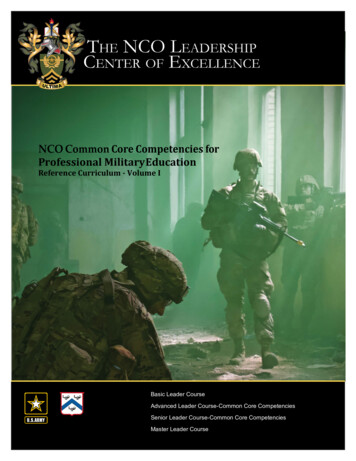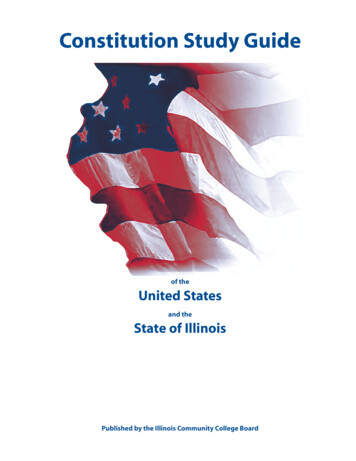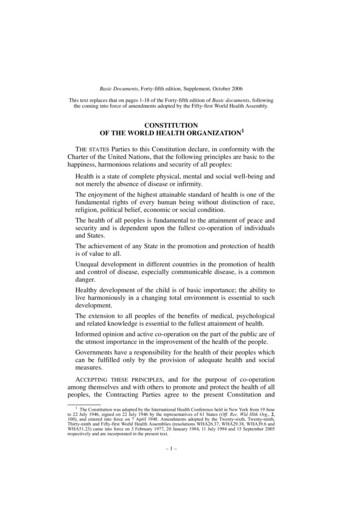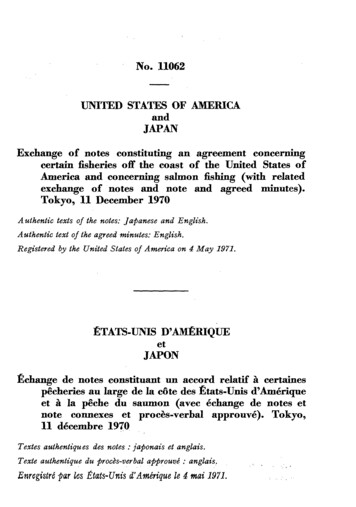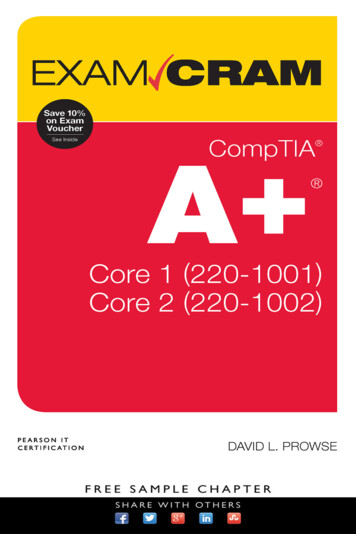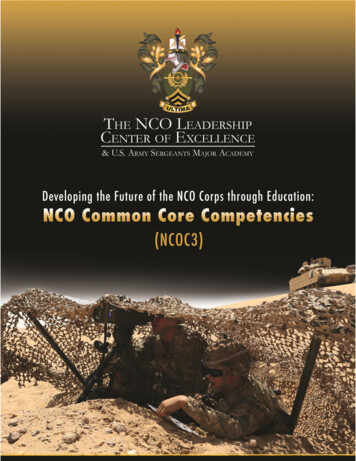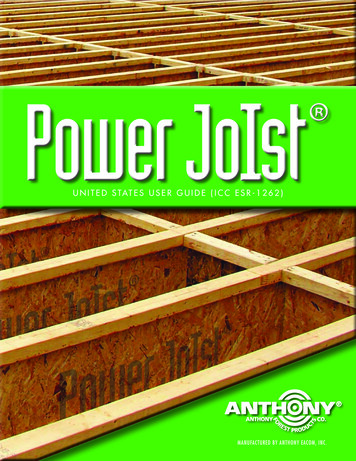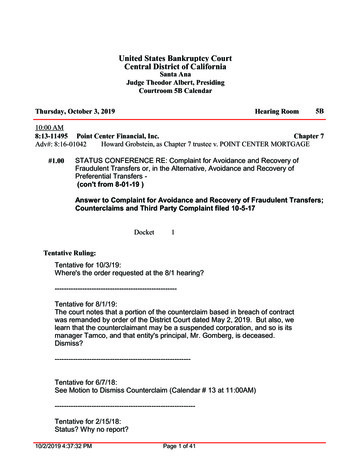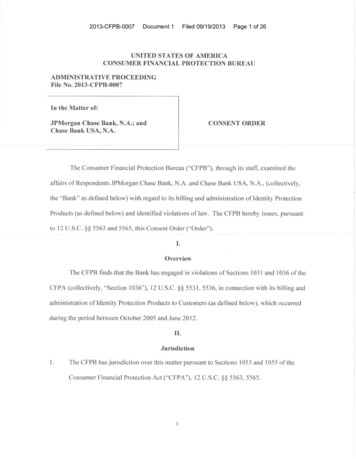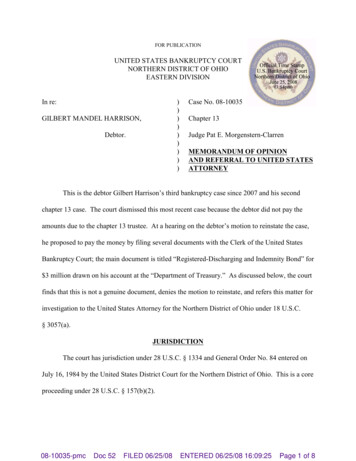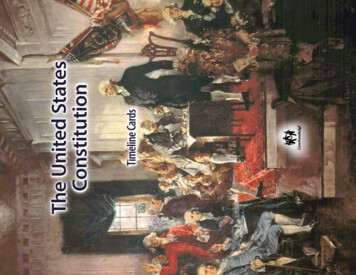
Transcription
Timeline CardsThe United StatesConstitution
Trademarks and trade names are shown in this bookstrictly for illustrative and educational purposes and arethe property of their respective owners. References hereinshould not be regarded as affecting the validity of saidtrademarks and trade names.Core Knowledge , Core Knowledge Curriculum Series ,Core Knowledge History and Geography and CKHG are trademarks of the Core Knowledge Foundation.All Rights Reserved.Copyright 2017 Core Knowledge mons.org/licenses/by-nc-sa/4.0/With the understanding that:For any reuse or distribution, you must make clear toothers the license terms of this work. The best way todo this is with a link to this web page:Share Alike—If you alter, transform, or build upon this work,you may distribute the resulting work only under the same orsimilar license to this one.Noncommercial—You may not use this work forcommercial purposes.This work is based on an original work of the CoreKnowledge Foundation (www.coreknowledge.org) madeavailable through licensing under a Creative CommonsAttribution-NonCommercial-ShareAlike 4.0 InternationalLicense. This does not in any way imply that the CoreKnowledge Foundation endorses this work.Under the following conditions:Attribution—You must attribute the work in thefollowing manner:You are free:to Share—to copy, distribute, and transmit the workto Remix—to adapt the workThis work is licensed under aCreative Commons Attribution-NonCommercial-ShareAlike4.0 International License.Creative Commons LicensingTitle The Signing of the Constitution of the United States in 1787, 1940(oil on canvas), Christy, Howard Chandler (1873–1952) / Hall ofRepresentatives, Washington D.C., USA / Bridgeman ImagesIntroduction, Card 1 Scott HammondIntroduction, Card 2 Scott HammondIntroduction, Card 2 Scott HammondIllustration and Photo CreditsJames S. Todd [Ph.D., University of Virginia (Government); J.D., University of Georgia]Tony Williams, Senior Teaching Fellow, Bill of Rights InstituteSubject Matter ExpertsIntroduction, Card 3 Scott HammondChapter 1Tetra Images/SuperStockChapter 2 Writing essays, 2009 (w/c on paper), Frey, Matthew (b.1974) /Private Collection / Wood Ronsaville Harlin, Inc. USA / BridgemanImagesChapter 4, Card 1 Portrait of James Madison, 1816 (oil on canvas), American School,(19th century) / White House, Washington D.C., USA / Photo GraphicaArtis / Bridgeman ImagesChapter 4, Card 1 Portrait of Alexander Hamilton (1757–1804) (oil on canvas),Trumbull, John (1756–1843) / White House, Washington D.C., USA/ Bridgeman ImagesChapter 4, Card 1 Gift of Thomas Jefferson Coolidge IV in memory of his greatgrandfather, Thomas Jefferson Coolidge, his grandfather, ThomasJefferson Coolidge II, and his father, Thomas Jefferson Coolidge III /National Gallery of ArtChapter 4, Card 2 Constitutional Convention (w/c on paper), Ferris, Jean Leon Gerome(1863–1930) / Private Collection / Bridgeman ImagesChapter 7, Card 2 Universal Images Group/SuperStockChapter 7, Card 3 Durga BenhardChapter 9, Card 1 Writing the Constitution, 2009 (w/c on paper), Harlin, Greg (b.1957) /Private Collection / Wood Ronsaville Harlin, Inc. USA / BridgemanImagesChapter 9, Card 2 SuperStock / SuperStockISBN: 978-1-68380-192-4
IntroductionIn 1765, the colonistsobjected to theBritish governmentcollecting taxes in thethirteen colonies.THE UNITED STATES CONSTITUTION
IntroductionGeorge Washington (left) and Thomas Jefferson (right) participated in the First Continental Congress,in 1774, which sent King George III a list of the colonists’ complaints.THE UNITED STATES CONSTITUTION
IntroductionIn 1775, the SecondContinentalCongress choseGeorge Washingtonto command theContinental Armyduring the AmericanRevolution.THE UNITED STATES CONSTITUTION
CHAPTER 1: The Idea of Self-RuleIn 1776, theDeclaration ofIndependence,written by ThomasJefferson, declaredthe colonies’separation fromBritain and theirestablishmentas “free andindependent states.”Big Question: What does self-government mean, andwhy was it such a revolutionary idea?THE UNITED STATES CONSTITUTION
CHAPTER 2: New Constitutions for the StatesFrom 1776–1780, eachof the thirteen stateswrote and adopted itsown state constitution.Big Question: What is a republic or a republican formof government?THE UNITED STATES CONSTITUTION
CHAPTER 3: The Articles of ConfederationIn 1777, the Second ContinentalCongress approved the Articlesof Confederation to form acentral government beyond theindividual state governments.Big Question: Why did the lack of a central governmentprove to be a problem?THE UNITED STATES CONSTITUTION
CHAPTER 4: Planning a New ConstitutionJames Madison (left), Alexander Hamilton (middle), George Washington (right), and others decided thatthe nation needed a stronger central government.Big Question: Why did James Madison and AlexanderHamilton think a stronger central government was needed?THE UNITED STATES CONSTITUTION
CHAPTER 4: Planning a New ConstitutionIn 1787, a convention was held in Philadelphiato reconsider the need for a stronger centralgovernment.Big Question: Whydid James Madison andAlexander Hamiltonthink a stronger centralgovernment was needed?THE UNITED STATES CONSTITUTION
CHAPTER 6: Some Major DecisionsThe convention delegatesdecided that they shouldwrite a new constitutionto form a stronger centralgovernment.Big Question: What was the Virginia Plan, and why mightsome delegates have objected to it?THE UNITED STATES CONSTITUTION
CHAPTER 7: Checks, Balances, and CompromisesThe new governmentwas organized into threebranches of government.Separation of PowersWe the People of the UnitedStates, in Order to form a moreperfect Union, establish Justice,insure domestic Tranquility,provide for the commondefence, promote the generalWelfare, and secure theBlessings of Liberty to ourselvesand our Posterity, do ordainand establish this Constitutionfor the United Statesof America.The ConstitutionThe Congress Passes lawsThe President Carries out the laws of Congress Suggests new lawsThe Supreme Court Settles argumentsabout the lawBig Question: What were the main challenges that hadto be overcome in order to create a new constitution?THE UNITED STATES CONSTITUTION
CHAPTER 7: Checks, Balances, and CompromisesRoger Sherman introduced a plan that shared powerbetween large and small states.Big Question: What werethe main challenges that hadto be overcome in order tocreate a new constitution?THE UNITED STATES CONSTITUTION
CHAPTER 7: Checks, Balances, and CompromisesThe slave trade continued,even though many peoplewere against slavery.Big Question: What were the main challenges that hadto be overcome in order to create a new constitution?THE UNITED STATES CONSTITUTION
CHAPTER 9: The States RatifyFinally, in 1789, theConstitution was ratified.Big Question: Why was it considered essential to have aBill of Rights added to the U.S. Constitution?THE UNITED STATES CONSTITUTION
CHAPTER 9: The States RatifyJames Madison led the movement to amendthe Constitution to include the Bill of Rights,which was ratified in 1791.Big Question: Whywas it consideredessential to have a Billof Rights added to theU.S. Constitution?THE UNITED STATES CONSTITUTION
CHAPTER 2: New Constitutions for the States Big Question: What is a republic or a republican form of government? From 1776–1780, each of the thirteen states wrote and adopted its own state constitution. THE UNITED STATES CONSTITUTION CHAPTER 3: The Articles of Confederation Big Question: Why did the lack of a central government prove to be a problem? In 1777, the Second Continental
